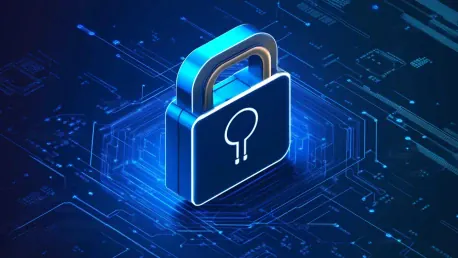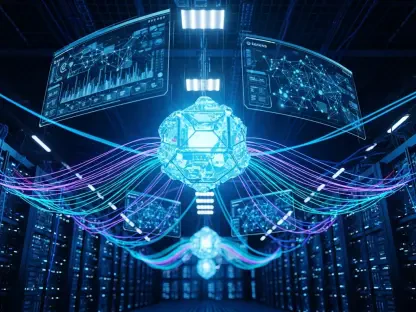In the rapidly evolving landscape of cybersecurity, organizations must adapt to new threats and challenges to maintain resilience. Traditional perimeter-based security models are becoming obsolete, and innovative strategies are essential to protect sensitive information. The continuous evolution of cyber threats underscores the importance of adopting proactive and forward-thinking measures. This article explores the top five network security trends that will shape organizational resilience by 2025, as identified by INE Security, a leading provider of networking and cybersecurity training and certifications.
AI-Driven Security Solutions
Revolutionizing Threat Detection and Response
Artificial intelligence (AI) is transforming the way organizations detect and respond to cyber threats. AI-driven security solutions offer capabilities that surpass human processing power, enabling predictive threat neutralization before network infiltration. These solutions can rapidly analyze complex attack patterns and adapt security responses in real-time. By processing massive amounts of network data, AI identifies vulnerabilities faster and with greater accuracy than traditional methods. The integration of AI into security protocols not only enhances threat detection but also allows for more efficient allocation of resources, focusing human expertise on strategic decision-making rather than routine monitoring tasks.
AI provides a unique advantage by recognizing and responding to evolving threats with unprecedented speed. As cybercriminals employ more sophisticated tactics, the ability of AI to learn and adapt becomes crucial. It can detect anomalies that might escape human notice, offering a level of scrutiny that enhances overall network security. Therefore, organizations need to invest in AI technologies and ensure their security teams are equipped to utilize these tools effectively. The shift towards AI-driven security is not just a technological upgrade but a strategic move towards a more resilient cybersecurity infrastructure.
Comprehensive AI Literacy Programs
To leverage AI effectively, organizations must ensure their security teams are well-versed in AI technologies. This involves implementing comprehensive AI literacy programs that include specialized training modules on AI threat detection, hands-on workshops simulating AI-powered attack scenarios, and ongoing learning paths to keep up with AI security innovations. Such training equips security teams with the skills needed to harness AI’s full potential in safeguarding networks. By fostering a deep understanding of AI’s capabilities and limitations, organizations can better integrate these technologies into their overall security strategy.
The necessity of AI literacy extends to understanding how AI algorithms work, their potential biases, and the importance of monitoring AI-driven decisions. Regular training sessions should be conducted to ensure that all team members are up-to-date with the latest AI developments and security protocols. Moreover, collaboration with AI experts and continuous learning will help organizations stay ahead of emerging cyber threats. As AI continues to evolve, a well-educated workforce will be essential in maximizing its benefits and mitigating potential risks associated with its deployment in security measures.
Zero Trust Architecture
Continuous Authentication and Granular Access Controls
The concept of implicit trust within network boundaries is fading, making Zero Trust architecture a critical security paradigm. This approach requires continuous authentication for all users and devices, granular access controls, and the elimination of implicit network trust. Organizations are moving towards verifying every access attempt, regardless of its origin, to enhance security. The Zero Trust model ensures that no user or device is trusted by default, adding layers of security that can adapt to the intricacies of modern network environments.
Adopting Zero Trust architecture involves implementing multi-factor authentication (MFA), enforcing strict access controls, and continuously monitoring network activity for suspicious behavior. This paradigm shift requires a cultural change within organizations, where security becomes a shared responsibility across all departments. Enhanced visibility into user activity and device interactions helps in identifying and mitigating potential threats before they can cause significant damage. As cybersecurity threats become more sophisticated, the Zero Trust model offers a robust framework for safeguarding sensitive data and maintaining organizational resilience.
Immersive Training Programs
To implement Zero Trust architecture effectively, organizations need immersive training programs. These should include workshops on role-based access control (RBAC), simulation exercises that reinforce continuous authentication principles, and organization-wide training to foster a security-first mindset at all levels. Such training ensures that all employees understand and adhere to Zero Trust principles, enhancing overall security. By engaging employees in hands-on training and real-world scenarios, organizations can better prepare their workforce to respond to security challenges effectively.
Immersive training programs should also address the importance of regular policy reviews and updates to adapt to the changing threat landscape. Continuous learning and development initiatives will help keep security teams informed about the latest Zero Trust practices and technologies. Additionally, collaboration and communication across departments are vital in creating a cohesive security strategy. By building a culture of security awareness and providing practical training, organizations can empower their employees to be proactive defenders of network security, making the entire structure more resilient.
IoT and Mobile Device Security
Addressing New Vulnerabilities
The proliferation of Internet of Things (IoT) devices and mobile endpoints introduces new vulnerabilities. Effective strategies for securing these devices include robust authentication protocols, comprehensive protection for the device ecosystem, and dynamic security measures tailored for diverse technological platforms. Each connected device represents a potential entry point for attacks, necessitating vigilant security measures. As IoT becomes more integrated into everyday business operations, the scope of potential vulnerabilities expands, making it crucial to implement stringent security protocols.
To combat the risks associated with IoT and mobile devices, organizations must focus on securing communication channels and ensuring data integrity across all endpoints. This includes deploying end-to-end encryption, regularly updating firmware, and conducting thorough security assessments. The diversity of IoT devices, ranging from simple sensors to complex industrial systems, requires a flexible and adaptive security approach. By identifying and addressing vulnerabilities specific to each device type, organizations can create a more secure and resilient network environment.
Device-Specific Security Awareness Programs
Security teams must understand risk mitigation strategies for IoT and mobile devices. This involves identifying potential IoT vulnerabilities and developing secure protocols for remote and mobile work environments. Training initiatives should include device-specific security awareness programs, IoT and mobile device certification courses, practical workshops on secure device management, and modules addressing the risks of diverse technological ecosystems. These programs equip security personnel with the knowledge and skills needed to protect a wide range of devices effectively.
Device-specific security awareness programs should also emphasize the importance of regular updates and patches to protect against emerging threats. Educating employees about safe practices for using IoT and mobile devices, such as avoiding unsecured networks and regularly changing passwords, can significantly enhance overall security. Additionally, conducting simulated attack scenarios can help teams identify and address potential weaknesses in real-time. By integrating comprehensive training with practical application, organizations can foster a proactive approach to IoT and mobile device security, ultimately enhancing their resilience against cyber threats.
Ransomware Defense
Proactive Threat Hunting and Incident Response
Ransomware attacks have become more targeted and sophisticated, requiring a shift in defense strategies. Organizations must prioritize proactive threat hunting, advanced backup and recovery infrastructure, comprehensive incident response planning, and continuous employee security awareness. The focus is increasingly on rapid, intelligent response rather than mere prevention. Proactive threat hunting involves actively searching for signs of potential ransomware threats within the network, rather than waiting for alerts.
Incident response plans should be meticulously detailed, outlining specific steps to be taken in the event of a ransomware attack. This includes isolating affected systems, communicating with stakeholders, and conducting forensic analyses to understand the attack’s origins and impact. Regular drills and simulations can help refine these plans, ensuring that teams are prepared to act swiftly and effectively under pressure. By combining proactive threat hunting with well-coordinated incident response strategies, organizations can minimize the potential damage caused by ransomware attacks and enhance their overall resilience.
Comprehensive Ransomware Training
Security teams need to recognize early warning signs of ransomware attacks, understand ransom negotiation and communication strategies, and build psychological resilience for cyber incidents. Training should encompass comprehensive ransomware response and prevention programs, realistic attack simulations, specialized incident response training, and psychological preparedness workshops. These initiatives prepare teams to handle ransomware threats effectively.
Comprehensive training programs should also focus on educating employees about common ransomware tactics, such as phishing and social engineering, and how to avoid falling victim to such attacks. Continuous learning and awareness campaigns can help ingrain best practices into the organizational culture. Furthermore, developing a psychological resilience framework can aid employees in managing stress and maintaining clarity during an actual ransomware attack, ensuring a more composed and effective response.
Cloud Security and Distributed Networks
Enhanced Encryption and Multi-Cloud Visibility
The adoption of cloud infrastructure requires innovative security approaches. Enhanced encryption technologies, full visibility across multi-cloud environments, advanced identity management, and seamless security integration are essential for securing cloud environments. Organizations must manage security across multiple technological platforms and maintain visibility in complex network configurations. As businesses increasingly rely on cloud services, the security landscape becomes more intricate, necessitating robust measures to protect sensitive data.
Enhanced encryption methods, such as homomorphic encryption and quantum-resistant algorithms, offer additional layers of protection for cloud-stored data. Multi-cloud environments, which involve the use of multiple cloud service providers, require centralized monitoring tools that provide comprehensive visibility into all activities. By implementing advanced identity management systems, organizations can ensure that only authorized users have access to critical resources. These measures, combined with continuous monitoring and threat detection, form the backbone of a resilient cloud security strategy.
Multi-Cloud Security Certifications
To secure cloud environments effectively, security teams must understand cloud security principles. Training must cover multi-cloud security certifications, advanced network architecture security, hands-on cross-platform security practices, and distributed network protection modules. These programs equip teams with the knowledge and skills needed to protect cloud-based assets effectively.
Multi-cloud security certifications validate a professional’s ability to manage and secure complex cloud infrastructures. By pursuing these credentials, security teams can stay abreast of the latest industry standards and best practices. Hands-on training and practical workshops help reinforce theoretical knowledge, providing valuable real-world experience. Additionally, focusing on distributed network protection helps organizations address the unique challenges posed by decentralized environments, ensuring comprehensive security across all platforms.
About INE Security
INE Security stands out as a leading provider of online networking and cybersecurity training and certification. The organization leverages a powerful hands-on lab platform, cutting-edge technology, a global video distribution network, and world-class instructors. As the top training choice for multinational companies and IT professionals aspiring to advance their careers, INE Security offers a suite of learning paths that provide deep expertise in cybersecurity. The company’s mission includes delivering advanced training while making it accessible worldwide for aspiring IT professionals.
INE Security’s commitment to excellence is reflected in its comprehensive course offerings and innovative training methodologies. By combining theoretical knowledge with practical application, INE Security ensures that its learners are well-prepared to tackle real-world cybersecurity challenges. The organization’s focus on accessibility and quality has made it a trusted name in the industry, empowering professionals to achieve their full potential and contribute to a safer digital landscape.
Summary
In today’s fast-changing cybersecurity environment, organizations need to constantly adapt to new threats and challenges to stay resilient. Traditional security approaches relying on protecting the network’s perimeter are becoming outdated, making novel strategies crucial for safeguarding sensitive data. The constant evolution of cyber threats highlights the need for proactive, forward-thinking measures. This article delves into the top five network security trends that INE Security, a leading authority in networking and cybersecurity education, believes will be pivotal for organizational resilience by 2025. With cyber threats growing more sophisticated, adopting these advanced security strategies is essential to ensure robust protection against potential breaches. INE Security’s insights on these trends provide a roadmap for companies looking to enhance their cybersecurity posture. By embracing these emerging trends, organizations can better prepare for the challenges of tomorrow and maintain the integrity of their sensitive information in an ever-evolving digital landscape.









